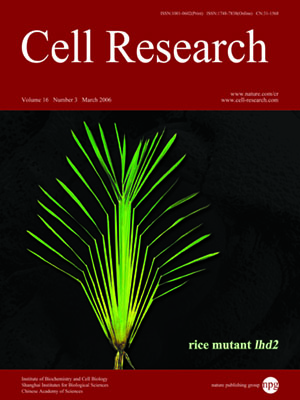
Volume 16, No 3, Mar 2006
ISSN: 1001-0602
EISSN: 1748-7838 2018
impact factor 17.848*
(Clarivate Analytics, 2019)
Volume 16 Issue 3, March 2006: 287-296
ORIGINAL ARTICLES
Molecular and functional characterization of sulfiredoxin homologs from higher plants
Xian Peng Liu1, 2, Xue Ying Liu1, 2, Juan Zhang1, 2, Zong Liang Xia1, 2, Xin Liu1, Huan Ju Qin1, Dao Wen Wang1
1The State Key Laboratory of Plant Cell and Chromosome Engineering, Institute of Genetics and Developmental Biology, Chinese Academy of Sciences, Datun Road, Chaoyang District, Beijing 100101, China; 2Graduate University of Chinese Academy of Sciences,Yuquan Road, Shijingshan District, Beijing 100039, China
Correspondence: Dao Wen Wang(dwwang@genetics.ac.cn )
By reducing cysteine-sulfinic acid in oxidized peroxiredoxin, sulfiredoxin (Srx) plays an important role in oxidation stress resistance in yeast and human cells. Here, we report the first molecular and functional characterization of Srx homolog from higher plants. Bioinformatic analysis revealed the presence of potential Srx encoding sequences in both monocot and dicot plant species. Putative plant Srx proteins exhibited significant identities to their orthologs from yeast and human, and contained the conserved signature sequence and residues essential for catalysis. However, unlike yeast and human orthologs, plant Srxs were all predicted to possess chloroplast transit peptide in their primary structure. The Srx proteins from Arabidopsis and rice (designated as AtSrx and OsSrx, respectively) complemented functional defi- ciency of Srx in the SRX1 deletion yeast cells. A GFP fusion protein of AtSrx was targeted to chloroplast in Arabidopsis mesophyll protoplast. AtSrx transcription occurred in both vegetative and reproductive organs, and the highest transcript level was detected in leaves. Under oxidation stress, AtSrx transcript level was substantially increased, which paralleled with enhanced transcription of 2-Cys peroxiredoxins that have been found essential in maintaining chloroplast redox balance. In addition to oxidation stress, osmotic/water deficit or cold treatments also raised AtSrx transcript level. Consistent with above findings, the knock-out mutant of AtSrx was significantly more susceptible to oxidation stress than wild type Arabidopsis plant. Taken together, the results of this work indicate the existence of functional Srx homolog in higher plants that is essential for plants to cope with oxidation stress.
Cell Research (2006) 16:287-296. doi:10.1038/sj.cr.7310036; published online 16 March 2006
FULL TEXT | PDF
Browse 1859


